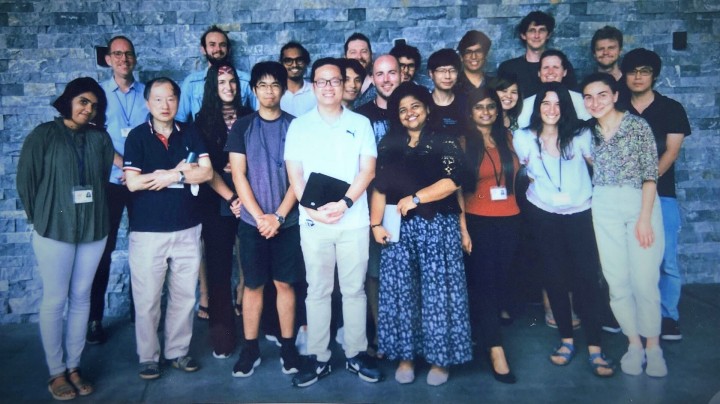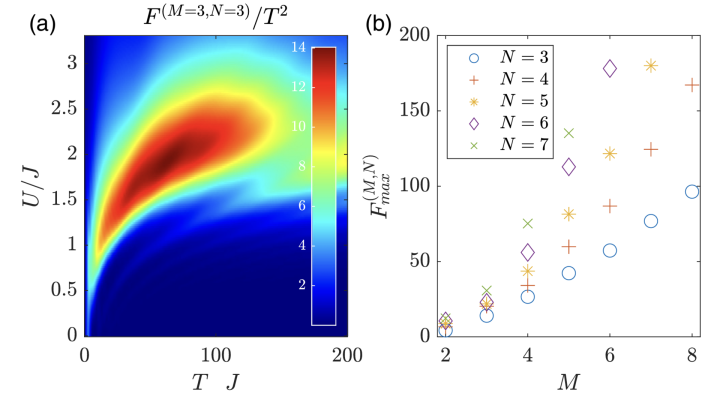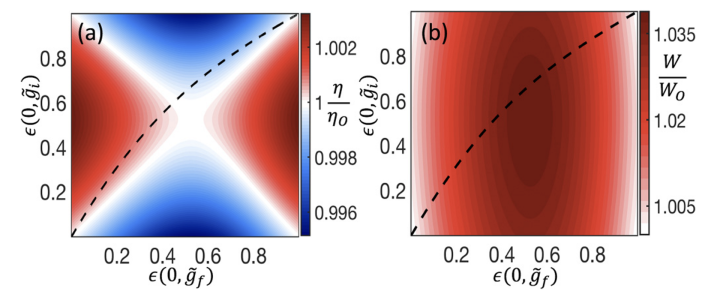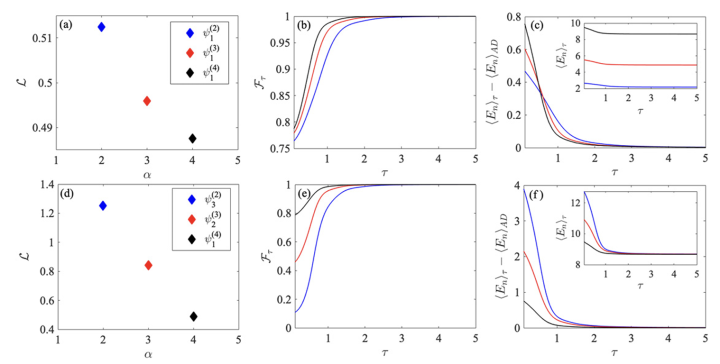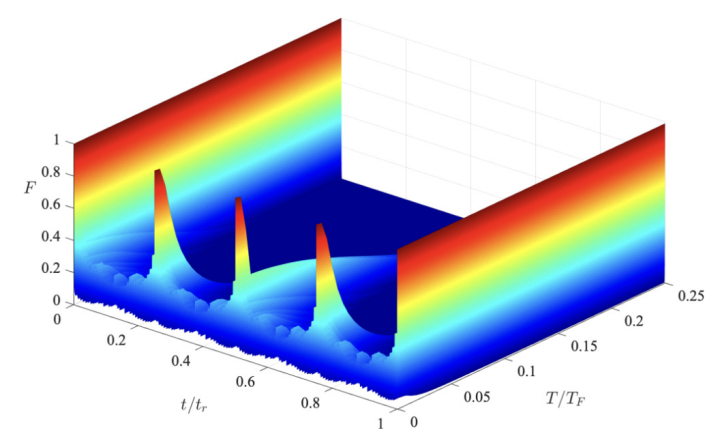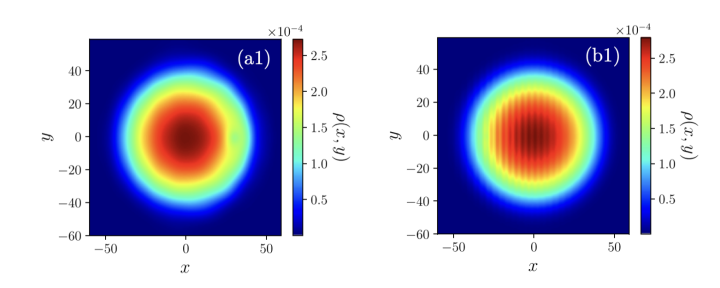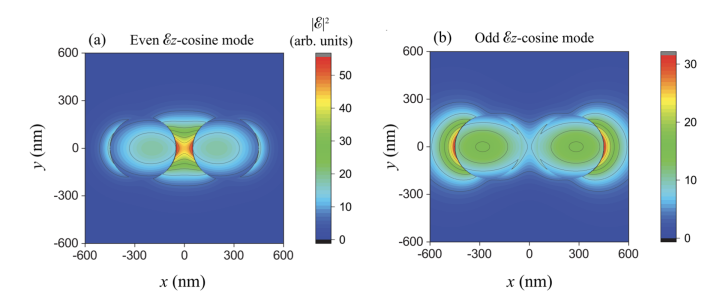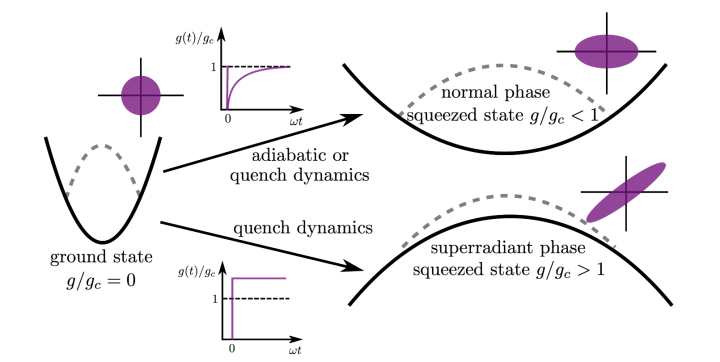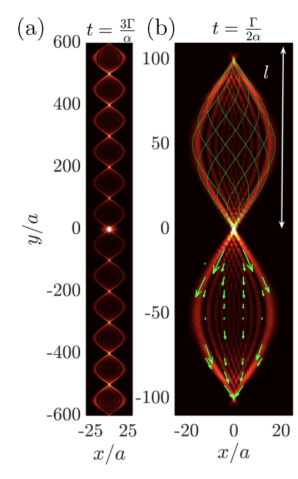Quantum Systems Unit
Professor Thomas Busch
Abstract
The past year has seen the graduation and departure of four PhD students from the group, and several outstanding post-docs and intern students have joined. Our work in Bose-Einstein condensates, quantum heat engines, quantum sensing, light-matter interactions and non-equilibrium quantum many-body systems has progressed and several new collaborations with international experimental groups have been started. It is an exciting time in our team and we have many interesting questions lined up to be answered for the next year.
1. Staff
- Dr. Pham Le Kien, Staff Scientist
- Dr. Thomás Fogarty, Staff Scientist
- Dr. Karol Gietka, JSPS Fellow/Postdoctoral Scholar
- Dr. Hao Lyu, Postdoctoral Scholar
- Dr. Sayyare Aksu, Postdoctoral Scholar
- Dr. Kritika Jain, Postdoctoral Scholar
- Dr. Eloisa Cuestas, Postdoctoral Scholar
- Dr. Wenbin He, Postdoctoral Scholar
- Dr. Giedrius Žlabys, Postdoctoral Scholar
- Mr. Christopher Campbell, PhD Student
- Mr. Tim Keller, PhD Student
- Ms. Friederike Metz, PhD Student
- Mr. Lewis Ruks, PhD Student
- Mr. Muhammad Sirajul Hasan, PhD Student
- Mr. Mohamed Boubakour, PhD Student
- Mr. Yuta Itoh, PhD Student
- Mr. Jose Carlos Pelayo, PhD Student
- Ms. Keerthy Menon, PhD Student
- Mr. Tai Tran, PhD Student
- Mr. Hoshu Hiyane, PhD Student
- Ms. Sarika Sasidharan Nair, PhD Student
- Ms. Sawako Koki, Research Unit Administrator
Rotation Students
- Mr. Raul Alejandro Hidalgo Sacoto (January-April, 2022)
- Mr. Daehee Kim (May-August, 2022)
Research Interns
- Mr. Gabriel Cofre, Yachay Tech University, Ecuador *graduated (May25-Sep 14)
- Ms. Salome Hayes-Shuotar, University College Dublin, Ireland (Jun 02- Sep 01)
- Ms. Yuliya Bilinskaya, Uppsala University, Sweden (Jun 15-Dec 12)
- Ms. Nikola Mang, TU Dortmund University, Germany (Oct 06 - Mar 22)
- Mr. Duc Hoang, Ho Chi Minh City University of Education, Vietnam (Oct 20 - Mar 31)
- Mr. Julián Ferreiro Vélez, University of the Basque Country, Spain (Mar 01 - Mar30)
2. Collaborations
2.1 Quantum thermodynamics
- Type of collaboration: Joint research
- Researchers:
- Prof. S. Campbell, University College Dublin, Ireland
- Prof. J. Goold. Trinity College Dublin, Ireland
2.2 Shortcuts to adiabaticity
- Type of collaboration: Joint research
- Researchers:
- Prof. A. Ruschhaupt, University College Cork, Ireland
- Prof. X. Chen, Bilbao, University of the Basque Country, Spain
2.3 Quantum engines
- Type of collaboration: Joint research
- Researchers:
- Prof. A. Widera, Kaiserslautern University, Germany
- Prof. E. Lutz, Stuttgart University, Germany
2.4 Spin-orbit coupled Bose-Einstein condensates
- Type of collaboration: Joint research
- Researchers:
- Prof. Y. Zhang, Shanghai University, China
2.5 Strongly correlated few-particle systems
- Type of collaboration: Joint research
- Researchers:
- Prof. M.-A. Garcia-March, Universidad Politécnica de Valencia, Spain
3. Activities and Findings
3.1 Distributed quantum sensing with optical lattices
In distributed quantum sensing the correlations between multiple modes, typically of a photonic system, are utilized to enhance the measurement precision of an unknown parameter. In this project we have investigated the metrological potential of a multimode, tilted Bose-Hubbard system and shown that it can allow for parameter estimation at the Heisenberg limit of [N(M-1)T]2, where N is the number of particles, M is the number of modes, and T is the measurement time. The quadratic dependence on the number of modes can be used to increase the precision compared to typical metrological systems with only two atomic modes and does not require correlations between different modes. We have shown that this limit can be reached by using an optimized initial state given as the superposition of all the atoms occupying the first and last lattice sites. We have also developed strategies that would allow one to obtain quadratic dependence on M of the Fisher information in a more realistic experimental setup.
3.2 Interaction enhanced quantum heat engine
We have studied a minimal quantum Otto heat engine, where the working medium consists of an interacting few-body system in a harmonic trap. This has allowed us to consider the interaction strength as an additional tunable parameter during the work strokes and calculate the figures of merit of this engine as a function of the temperature, clearly showing in which parameter regimes the interactions assist in engine performance. We have also studied the finite-time dynamics and the subsequent tradeoff between the efficiency and the power, and compared the interaction-enhanced cycle with the case where the system remains scale-invariant.
3.3 Direction-dependent coupling between a nanofiber-guided light field and a two-level atom with an electric quadrupole transition
We have studed the directional dependence of the coupling between a nanofiber-guided light field and a two-level atom with an electric quadrupole transition. For this we have examined the situation where the nanofiber is aligned along the z axis, the atom lies on the fiber transverse x axis, the quantization axis for the atomic internal states is the other orthogonal transverse y axis, the atomic upper and lower levels are the magnetic sublevels M′ and M of hyperfine-structure levels of an alkali-metal atom, and the field is in a quasilinearly polarized fundamental guided mode HE11 with the polarization ξ=x or y. We have found that the absolute value of the quadrupole Rabi frequency depends on the propagation direction of the light field in the cases of (M′−M=±1, ξ=y) and (M′−M=±2, ξ=x). We have shown that the directional dependence of the coupling leads to the directional dependence of spontaneous emission into guided modes and found that the directional dependence of the atom-field coupling in the case of quadrupole transitions is not entirely due to spin-orbit coupling of light: there are some other contributions resulting from the gradient of the spatial phase factor of the field.
Publication:
Direction-dependent coupling between a nanofiber-guided light field and a two-level atom with an electric quadrupole transition
Fam Le Kien, Síle Nic Chormaic, and Thomas Busch
Phys. Rev. A 107, 013713 (2023)
3.4 Quantum control and quantum speed limits in supersymmetric potentials
Supersymmetry allows one to build a hierarchy of Hamiltonians that share the same spectral properties and which are pairwise connected through common super-potentials. The iso-spectral properties of these Hamiltonians imply that the dynamics and therefore control of different eigenstates are connected through supersymmetric intertwining relations. In this work we have explored how this enables one to study general dynamics, shortcuts to adiabaticity and quantum speed limits for distinct states of different supersymmetric partner potentials by using the infinite box as an example.
3.5 Transfer of angular momentum of guided light to an atom with an electric quadrupole transition near an optical nanofiber
We have studied the transfer of angular momentum of guided photons to a two-level atom with an electric quadrupole transition near an optical nanofiber. We have shown that the generation of the axial orbital torque of the driving guided field on the atom is governed by the internal-state selection rules for the quadrupole transition and by the angular momentum conservation law with the photon angular momentum given in the Minkowski formulation. We have found that the torque depends on the photon angular momentum, the change in the angular momentum of the atomic internal state, and the quadrupole-transition Rabi frequency. We show that the absolute value of the torque for the higher-order mode HE21 is larger than that of the torque for the fundamental mode HE11 except for the case M′−M=2, where the torque for the mode HE21 is vanishing.
Publication:
Transfer of angular momentum of guided light to an atom with an electric quadrupole transition near an optical nanofiber
Fam Le Kien, Sile Nic Chormaic, Thomas Busch
Phys. Rev. A 106, 013712 (2022)
3.6 Non-equilibrium many-body dynamics in supersymmetric quenching
We have studied the dynamics induced by quenching an ultracold quantum many-body system between two supersymmetric Hamiltonians. Such a quench can be created by carefully changing the external trapping potential and leads to a situation where the eigenspectra before and after the quench are nearly identical. We have shown that the dynamics originating from this can be conveniently described using knowledge about the initial state only and apply this insight to the specific example of a fermionic gas that is initially trapped in an infinite box potential. When quenching to different, higher order supersymmetric partners potentials we have observed the appearance of many-body revivals in the survival probability and shown that some of these are robust at finite temperatures. This is in contrast to the well-known Talbot effect, which is the standard example for quenching into a system with a quadratic spectrum.
3.7 Detection of roton and phonon excitations in a spin-orbit-coupled Bose-Einstein condensate with a moving barrier
We have proposed to detect phonon and roton excitations in a two-dimensional Bose-Einstein condensate with Raman-induced spin-orbit coupling by perturbing the atomic cloud with a weak barrier. The two excitation modes can be observed by moving the barrier along different directions in appropriate parameter regimes. Phonon excitations are identified by the appearance of solitary waves, while roton excitations lead to distinctive spatial density modulations. We have shown that this method can also be used to determine the anisotropic critical velocities of superfluid.
3.8 Optical force between two coupled identical parallel optical nanofibers
We have studied the optical force between two coupled parallel identical nanofibers using the rigorous array mode theory. We have numerically demonstrated for the coupled nanofibers that the forces of the even array modes are attractive, while the forces of the odd array modes are repulsive. We have examined the dependencies of the optical forces on the array mode type, the fiber radius, the light wavelength, and the fiber separation distance. We have shown that for a given power and a given separation distance, the absolute value of the force achieves a peak when the fiber radius and the light wavelength are appropriate.
3.8 Bloch oscillations in supersolids
We have shown that the motion of an accelerated atomic impurity immersed in a spin–orbit coupled Bose–Einstein condensate in the supersolid stripe phase undergoes oscillations, similar to the well-known phenomenon of Bloch oscillations in solids. While the back-action of the oscillatory movement onto the condensate excites phonon modes inside the supersolid, it does not affect the position of the roton minimum and therefore not the periodicity of the matter wave lattice. The ultimate decay of the oscillations is mostly due to the dispersion of the wavepacket and we show that this can be counteracted to a large extent by assuming that the impurity is a bright soliton.
3.9 Repulsive Casimir-Polder potentials of low-lying excited states of a multilevel alkali-metal atom near an optical nanofiber
We have studied the Casimir-Polder potential of a multilevel alkali-metal atom near an optical nanofiber. We have calculated the mean potential of the atom in a fine-structure state and performed numerical calculations for the Casimir-Polder potentials of the ground state and a few low-lying excited states of a rubidium atom. We have shown that, unlike the potential of the ground state, which is negative and attractive, the potential of a low-lying excited state may take positive values, oscillate around the zero value with a decaying amplitude, and become repulsive in some regions of atom-to-surface distances.
Publication:
Repulsive Casimir-Polder potentials of low-lying excited states of a multilevel alkali-metal atom near an optical nanofiber
Fam Le Kien, D. F. Kornovan, Sile Nic Chormaic, Thomas Busch
Phys. Rev. A 105, 042817 (2022)
3.10 Understanding and Improving Critical Metrology. Quenching Superradiant Light-Matter Systems Beyond the Critical Point
We have carefully examined critical metrology and present an improved critical quantum metrology protocol which relies on quenching a system exhibiting a superradiant quantum phase transition beyond its critical point. We have shown that this approach can lead to an exponential increase of the quantum Fisher information in time with respect to existing critical quantum metrology protocols relying on quenching close to the critical point and observing power law behaviour. We hvae demonstrated that the Cramér-Rao bound can be saturated in our protocol through the standard homodyne detection scheme and we have explicitly show its advantage using the archetypal setting of the Dicke model and explored a quantum gas coupled to a single-mode cavity field as a potential platform. In this case an additional exponential enhancement of the quantum Fisher information can in practice be observed with the number of atoms N in the cavity, even in the absence of N-body coupling terms.
3.11 Green's functions of and emission into discrete anisotropic and hyperbolic baths
We have studied wave propagation in generic Hermitian local periodic baths and investigate the effects of anisotropy and quasibreaking of periodicity on resonant emission into the band of the bath. For this we have asymptotically decomposed the Green's function into long-range traveling waves composed of all wave vectors (near) resonant at the emitter frequency and rapidly decaying evanescent waves. Our approximation then converges exponentially with increasing source-receiver separation ρ when resonant wave packets with group velocity parallel to ρ exist. In hyperbolic media this condition may not be satisfied, and we find that the exponential decay length of oscillating evanescent waves locally around caustics generally depends as a power law with exponent 3/2 on the angle made between ρ and the caustic. For ρ beyond the caustic we have observed that the Green's function can become almost imaginary, which results in exclusively incoherent emitter-emitter interactions and allows the simulation of purely dissipative systems with short-range interactions. Here the interaction length is tunable via the separation vector of the emitters. We have probed the hyperbolic dispersion beyond the previous regimes by applying an artificial gauge field on the lattice and found that emission resonant with the corresponding open orbits in the Brillouin zone is quasi one dimensional, in contrast to an isotropic environment. The quasi-one-dimensional emission is further topologically protected against local and global lattice perturbations and periodically refocusing, offering a robust bidirectional transport of excitations in higher-dimensional media.
4. Publications
4.1 Journal
- Soft parameters in Coulomb potential of noble atoms for nonsequential double ionization: Classical ensemble model and simulations
Thu D.H.Truong, Hanh H.Nguyen, Hieu B.Le, Do HungDung, H.-M.Tran, Nguyen DuyVy,Tran DuongAnh-Tai, Vinh N.T.Pham
Comput. Phys. Commun. 276 108372 (2022) - Green's functions of and emission into discrete anisotropic and hyperbolic baths
L. Ruks and Th. Busch
Phys. Rev. Research 4, 023044 (2022) - Understanding and Improving Critical Metrology. Quenching Superradiant Light-Matter Systems Beyond the Critical Point
Karol Gietka, Lewis Ruks, and Thomas Busch
Quantum 6, 700 (2022) - Squeezing by Critical Speeding-up. Applications in Quantum Metrology
Karol Gietka
Phys. Rev. A 105, 042620 (2022) - Repulsive Casimir-Polder potentials of low-lying excited states of a multilevel alkali-metal atom near an optical nanofiber
Fam Le Kien, D. F. Kornovan, Sile Nic Chormaic, Thomas Busch
Phys. Rev. A 105, 042817 (2022) - Rubidium atom spectral lineshapes in high intensity light fields near an optical nanofibre
Vandna Gokhroo, Fam Le Kien and Síle Nic Chormaic
J. Phys. B: At. Mol. Opt. Phys. 55 125301 (2022) - Bloch oscillations in supersolids
Muhammad S. Hasan, J. Polo, J.C. Pelayo, Th. Busch
J. Phys. B: At. Mol. Opt. Phys. 55 135302 (2022) - Intensity Dependence of Coulomb-Repulsion Effect in Strong-Field Nonsequential Double Ionization
T.D.H. Truong, T.D. Anh-Tai, H.H. Nguyen, N.H. Nha, D.H. Dung, V.N.T. Pham
A. Phys. Pol. A 141 569 (2022) - Optical force between two coupled identical parallel optical nanofibers
Fam Le Kien, Sile Nic Chormaic, Thomas Busch
Phys. Rev. A 105, 063517 (2022). - Detection of roton and phonon excitations in a spin-orbit-coupled Bose-Einstein condensate with a moving barrier
Hao Lyu, Yongping Zhang, Thomas Busch
Phys. Rev. A 106, 013302 (2022) - Non-equilibrium many-body dynamics in supersymmetric quenching
Christopher Campbell, Thomás Fogarty, Thomas Busch
Phys. Rev. Research 4, 033014 (2022). - Transfer of angular momentum of guided light to an atom with an electric quadrupole transition near an optical nanofiber
Fam Le Kien, Sile Nic Chormaic, Thomas Busch
Phys. Rev. A 106, 013712 (2022). - Elementary excitations in a spin–orbit-coupled spin-1 Bose–Einstein condensate
Yuanyuan Chen, Hao Lyu, Yong Xu and Yongping Zhang
New J. Phys. 24 073041 (2022) - Quantum control and quantum speed limits in supersymmetric potentials
Christopher Campbell, Jing Li, Thomas Busch, Thomás Fogarty
New J. Phys. 24 095001 (2022) - Two-dimensional Thouless pumping in time-space crystalline structures
Y. Braver, C.-h. Fan, G. Žlabys, E. Anisimovas, and K. Sacha
Phys. Rev. B 106, 144301 (2022) - Harnessing center-of-mass excitations in quantum metrology
Karol Gietka
Phys. Rev. Research 4, 043074 (2022) - Direction-dependent coupling between a nanofiber-guided light field and a two-level atom with an electric quadrupole transition
Fam Le Kien, Síle Nic Chormaic, and Thomas Busch
Phys. Rev. A 107, 013713 (2023) - Interaction enhanced quantum heat engine
Mohamed Boubakour, Thomás Fogarty, and Thomas Busch
Phys. Rev. Research 5, 013088 (2023) - Squeezing and Overcoming the Heisenberg Scaling with Spin-Orbit Coupled Quantum Gases
Karol Gietka, Helmut Ritsch
Phys. Rev. Lett. 130, 090802 (2023) - Composite-boson formalism applied to strongly bound fermion pairs in a one-dimensional trap
Martín D. Jiménez, Eloisa Cuestas, Ana P. Majtey, Cecilia Cormick
SciPost Phys. Core 6, 012 (2023) - Distributed quantum sensing with optical lattices
J.C. Pelayo, K. Gietka, and Th. Busch
Phys. Rev. A 107, 033318 (2023).
4.2 Books and other one-time publications
Nothing to report
4.3 Oral and Poster Presentations
4.3.1 Conference Invited Talk
- Th. Busch, Self-Pinning Transition of a Tonks-Girardeau Gas in a Bose-Einstein Condensate. ECAMP 14, Vilnius, Lithuania, 27 June (2022)
- Th. Busch, Making statistics work: a quantum engine in the BECBCS crossover, JSPS London Symposium: Non-Equilibrium Dynamics, Thermodynamics and Fluctuations: From Fundamentals to the Next Generation of Microscopic Thermal Machines, Nottingham, UK, 13 December (2022)
- Th. Busch, Quantum Simulations, Interdisciplinary Science Conference in Okinawa, OIST, 28 February (2023)
4.3.2 Conference Oral Presentation
- Fogarty, T. Self-Pinning Transition of a Tonks-Girardeau Gas in a Bose-Einstein Condensate,Ultracold Atoms Japan, OIST, 12 April (2022)
- Gietka, K. Harnessing ultracold center-of-mass excitations in quantum metrology, Ultracold Atoms Japan, OIST, 14 April (2022)
- Busch, T. Efficient Quantum Engines in Interacting Ultracold Gases, Entropy and the Second Law of Thermodynamics – The past, the present, and the future, Bad Honnef, Germany, 14 July (2022)
- Busch, T. Dynamics of Atoms in Complex Nanoscale Potentials, Quantum Transport with ultracold atoms, MPIPKS Dresden, Germany, 1 September (2022)
- Metz, F. Self-Correcting Quantum Many-Body Control using Reinforcement Learning with Tensor Networks, Machine Learning in Natural Sciences: From Quantum Physics to Nanoscience and Structural Biology, Hamburg, Germany, 19 September (2022)
4.3.3 Conference Poster Presentation
- H. Hiyane, T. Keller, T. Fogarty and Th. Busch, Excitation spectrum of a Tonks-Girardeau gas trapped in BEC, Ultracold Atoms Japan, OIST, 12-14 April (2022)
- Tim Keller,Thomas Fogarty, and Thomas Busch, Self-pinning transition of a Tonks-Girardeau gas in a Bose-Einstein condensate, Ultracold Atoms Japan, OIST, 12-14 April (2022)
- J.C. Pelayo , K. Gietka, Th. Busch, Distributed quantum sensing in a multi-mode atomic system, Atomtronics 2022, Benasque, Spain. 3 May (2022)
- Tim Keller, Thomás Fogarty, and Thomas Busch, Self-pinning transition of a Tonks-Girardeau gas in a Bose-Einstein condensate, FINESS 2022, St. Martin, Germany. 5 May (2022)
- J.C. Pelayo, T. Suzuki , M. Gohlke, Dynamical properties of the Kitaev-Gamma chain, Highly Frustrated Magnetism 2022, Paris, France. Online, 28 June (2022)
- H. Lyu, Y. Zhang, and Th. Busch, Detection of roton and phonon excitations in a spin-orbit coupled Bose-Einstein condensate with a moving barrier, 29th International Conference on Low Temperature Physics, Sapporo, Japan, 19 August (2022)
- K. Jain, F. Le Kien, L. Ruks, Th Busch, Coupling of atoms to double nanofiber systems : Versatile tools for quantum technologies, NanoQI Summerschool 2022 - Nanotechnology meets Quantum Information, Donostia-San Sebastian, Spain (2022)
4.3.4 Seminar
- Metz, F. Self-Correcting Quantum Many-Body Control using Reinforcement Learning with Tensor Networks, Flatiron Institute, New York, USA. Online, 27 April (2022)
- Metz, F. Self-Correcting Quantum Many-Body Control using Reinforcement Learning with Tensor Networks, The Institute of Photonic Sciences (ICFO), Barcelona, Spain. 3 May (2022)
- Muhammad Sirajul Hasan, Supersolid phase and career opportunities in Japan, National Institute of Technology Tiruchirappalli, India, 8 February (2023)
- Serhan Aksu, Self-pinning transition of a Fermi gas immersed in a Bose gas, Kindai University, 1 March (2023)
5. Intellectual Property Rights and Other Specific Achievements
Nothing to report
6. Seminar, Meetings and Events
6.1 Seminar
6.1.1 An analytical method for solving Schrödinger equation with multivortex initial conditions: applications and extensions to non-linear optics and Bose-Einstein condensates
- Date: October 25, 2022
- Venue: OIST Campus Lab 4
- Speaker: Miguel Angel Garcia-March (Distinguished Researcher, Valencia Polytechnic University, Spain)
6.1.2 Persistent current fractional quantization in atomtronic circuits
- Date: November 4, 2022
- Venue: OIST Campus Lab 3
- Speaker: Juan Polo Gomez (Postdoctoral Researcher, VQuantum Research Centre, Technology Innovation Institute, UAE)
6.1.3 Unitary few- and many-body problems in ultracold Fermi gases
- Date: November 14, 2022
- Venue: OIST Campus Center Building
- Speaker: Shimpei Endo (Assistant Professor, Tohoku Unviersity, Japan)
6.1.4 Periodically driven sub-wavelength lattices
- Date: November 28, 2022
- Venue: OIST Campus Center Building
- Speaker: Gediminas Juzeliūnas (Professor, Institute of Theoretical Physics and Astronomy, Vilnius University, Lithuania)
6.1.5 Assisting Neutron Science with Machine Learning techniques
- Date: February 2, 2023
- Venue: OIST Campus Lab3
- Speaker: José I. Robledo (Postdoctoral Researcher, Jülich Centre for Neutron Science, Germany)
6.1.6 Entropic characterization of quantum states with maximal evolution under given energy constraints
- Date: February 14, 2023
- Venue: OIST Campus Lab4
- Speaker: Ana Majtey (Professor, University of Cordoba, Argentina)
6.1.7 Dynamics of dipolar BECs exposed to a rotating magnetic field and vortex generation in supersolids
- Date: March 3, 2023
- Venue: OIST Campus Center building
- Speaker: Simeon Mistakidis (ITAMP postdoctoral fellow, Harvard University, USA)
6.1.8 Dynamics of Ultracold Quantum Gases
- Date: March 13, 2023
- Venue: OIST Campus Lab4
- Speaker: Tetsuro Nikuni (Professor, Tokyo University of Science, Japan)
6.2 Meetings and Events
6.2.1 Ultracold Atoms Japan 2022
- Date: 12 - 14 April, 2020
- Venue: OIST/ Zoom
- Organizers:
- Thomas Busch, OIST Graduate University
- Shin Inouye, Osaka City University
- Yuki Kawaguchi, Nagoya University
- Munekazu Horikoshi, Osaka City University
- Takeshi Fukuhara, Riken
6.2.2 OIST & ASJ Quantum/Cyber Security Seminar Series: Series 4 Public-key cryptography is bad for security
- Date: 19 April, 2022
- Venue: Webinar
- Speaker: Daniel Shiu
- Navigator: Kae Nemoto
- Organizers:
- OIST Graduate University (President Offce, Busch U)
- Asia Society Japan
7. Other
Nothing to report.





